James Webb Space Telescope has comets to catch when science begins
One might even be an interstellar visitor.

Comets have mystified humanity for millennia, but with the James Webb Space Telescope beginning science operations this month, scientists hope to unravel secrets about these icy objects.
In a study led by Heidi Hammel, executive vice president of the Association of Universities for Research in Astronomy and a Webb interdisciplinary scientist, the James Webb Space Telescope's powerful infrared instruments will be trained on three comets in the solar system. The goal will be to analyze the comets' chemical compositions. Because comets are some of the most primitive bodies in the solar system, this information could reveal clues about the solar system's early life.
"We want to study comets with Webb because of the telescope's very powerful capabilities in the near- and mid-infrared," Hammel said in a statement. "What makes those wavelengths of light particularly powerful for cometary studies is that they allow us to study the chemical makeup of this dust and gas that's come off of the comet's nucleus and figure out what it is."
Related: James Webb Space Telescope's groundbreaking optics explained by NASA
Hammel's team will observe three comets, each from a different comet family. The first will be a Jupiter-family comet — potentially Comet Borrelly, whose orbit is affected by the gas giant's gravity. The second will be a main belt comet — likely Comet Read.
The third will be what's called a "target-of-opportunity comet," meaning a comet that hasn't been discovered yet. The researchers hope that this third comet will be spotted by Webb before the beginning of this study and that it will belong to a different comet family than the other two targets. In one possible scenario, the team would be able to study an Oort Cloud comet that might have originated on the outskirts of the solar system. Another possible "opportunity comet" might originate from even farther afield, as did the interstellar objects 'Oumuamua and C/2019 Q4 (Borisov).
"One of Webb's strengths is its ability to sense faint objects, and that makes it a great tool to study these very rare and very faint interstellar interlopers," Hammel said. "If we could glean compositional information about its surface, that might open a whole new field of study."
Get the Space.com Newsletter
Breaking space news, the latest updates on rocket launches, skywatching events and more!
These three comets will be some of the first observed by Webb, but they certainly won't be the last.
"Ultimately, these are just individual examples, but over Webb's lifetime, we'll eventually observe many comets, and we'll have lots of examples from these different classes, and we can compare them all to each other," Michael Kelley, an associate research scientist at the University of Maryland who is leading the observations of the Jupiter-family and main belt comets, said in the statement. "With time — and in conjunction with all the ground-based data that we've had and will continue to obtain — we'll have a better understanding of where these comets come from."
The study is part of Cycle 1 of the Guaranteed Time Observations program, which will occur during Webb's first year of operations.
Follow Stefanie Waldek on Twitter @StefanieWaldek. Follow us on Twitter @Spacedotcom and on Facebook.
Join our Space Forums to keep talking space on the latest missions, night sky and more! And if you have a news tip, correction or comment, let us know at: community@space.com.

Space.com contributing writer Stefanie Waldek is a self-taught space nerd and aviation geek who is passionate about all things spaceflight and astronomy. With a background in travel and design journalism, as well as a Bachelor of Arts degree from New York University, she specializes in the budding space tourism industry and Earth-based astrotourism. In her free time, you can find her watching rocket launches or looking up at the stars, wondering what is out there. Learn more about her work at www.stefaniewaldek.com.









